Brief

At a Glance
- Most companies call pricing a high priority in our global survey, but 85% say they have significant room for improvement in pricing.
- Top-performing companies behave differently. They tailor pricing at the transaction level, align sales incentives with pricing strategy, and invest more heavily in ongoing training and tools.
- With significant margin upside at stake, companies cannot afford to continue pricing by guesswork or rules of thumb.
Poor pricing practices are insidious—they damage a company’s economics but can go unnoticed for years. For example, a major industrial goods manufacturer struggled with low profit margins, relative both to competitors and its own historical performance. It traced much of the cause to a mismatch between its sales incentives and pricing strategy. The manufacturer was compensating sales representatives based solely on how much new revenue they generated. Reps thus had little motivation to protect price levels on any given deal, and most were closing deals at the lowest permissible margin.
As with this manufacturer, many business-to-business (B2B) companies have a major opportunity to improve their standing on price. To help B2B companies understand the state of pricing capabilities and how they figure into company performance, Bain & Company conducted a global survey of sales leaders, vice presidents of pricing, CEOs, CMOs and other executives at more than 1,700 companies. We gathered their self-rating of 42 pricing capabilities and outcomes.
Roughly 85% of respondents believe their pricing decisions could improve. While most executives suggest pricing is a high priority, the survey shows that, on average, large capability gaps exist in price and discount structure, sales incentives, use of tools and tracking, and structuring cross-functional pricing teams and forums.
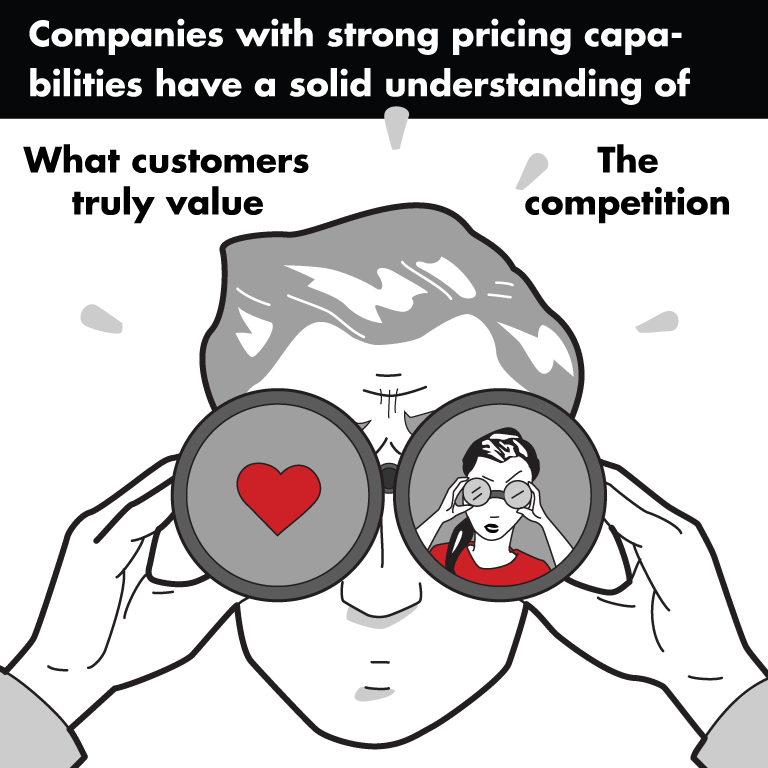
Dialing in Perfect B2B Pricing
The better your company’s pricing abilities, the better its performance.
What pricing leaders do differently
To understand which capabilities matter most, we studied a subset of top-performing companies, as defined by increased market share, self-described excellent pricing decisions and execution of regular price increases. While different pricing capabilities may be important for a particular situation, the analysis showed that top performers exceed their peers primarily in three areas (see Figure 1). Top performers are more likely to:
- employ truly tailored pricing at the individual customer and product level;
- align incentives for frontline sales staff with the pricing strategy to encourage prudent pricing through an appropriate balance of fixed and variable compensation; and
- invest in ongoing development of capabilities among the sales and pricing teams through training and tools.
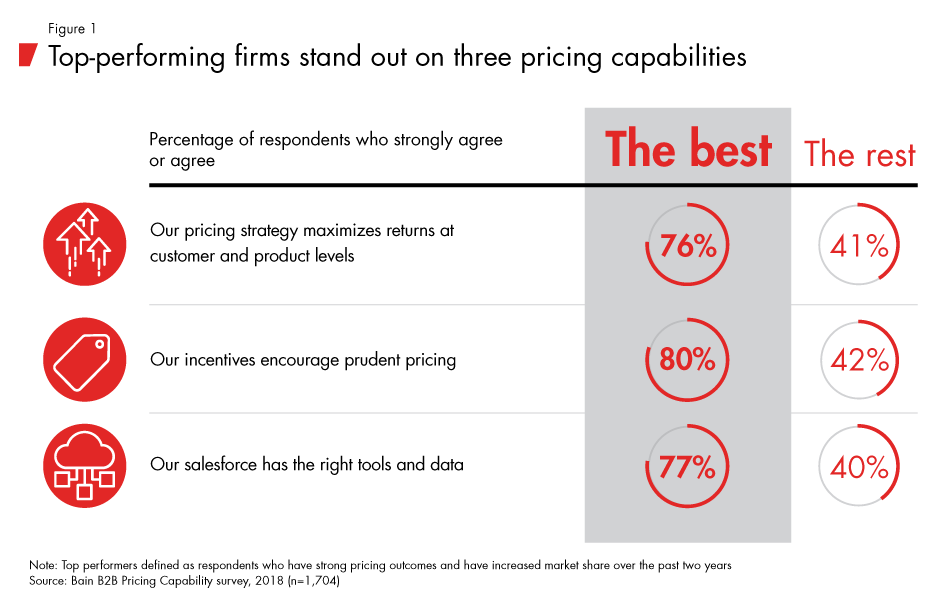
Our analysis also revealed just how much excelling across multiple pricing capabilities pays off. Among the companies that excel at all three areas, 78% are top performers (see Figure 2). Let’s explore why these three areas have such a strong effect on pricing.

Pricing to the average is always wrong
One-size-fits-all pricing actually fits no one. Yet it is not unusual for sales executives to admit that “our ability to tailor prices at the customer and transaction level is rudimentary at best” or that “we are not even aware of how much margin we make on deals.”
By contrast, more advanced companies tailor their pricing carefully for each combination of customer and product, continually working to maximize total margin. They bring data and business intelligence to bear on three variables for setting target prices:
- the attributes and benefits that customers truly value, and how much value is created for them;
- the alternatives and competitive intensity in the business; and
- the true profitability of the transaction after netting out leakage in areas such as rebates, freight, terms and inventory holding.
One North American manufacturer with margins that were highly dependent on raw material pricing suffered from an undisciplined approach to pricing. A diagnosis allocated costs at the product and customer level to determine true profitability (see Figure 3). That diagnosis provided the support needed to raise prices where appropriate in subsequent contract negotiations, leading to an average 4% increase. The company designated an executive to own related margin opportunities and track the status and effect of each price increase. As a result, the company improved earnings before interest, taxes, depreciation and amortization by 7 percentage points.
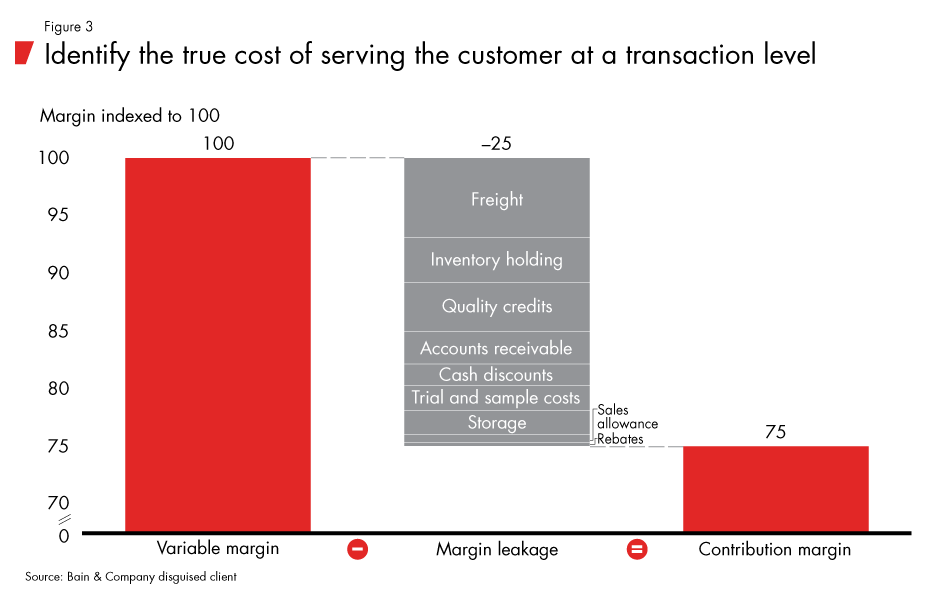
Bad incentives undercut the best pricing strategy
Managers often criticize sales reps for losing a deal but rarely for pricing a deal too low, so reps learn to concede on price until the deal closes. Moreover, companies rarely reward sales reps for exceeding price targets, which means few of them take risks to push for a higher price. Misaligned incentives push deals down to the minimum allowed price (see Figure 4).
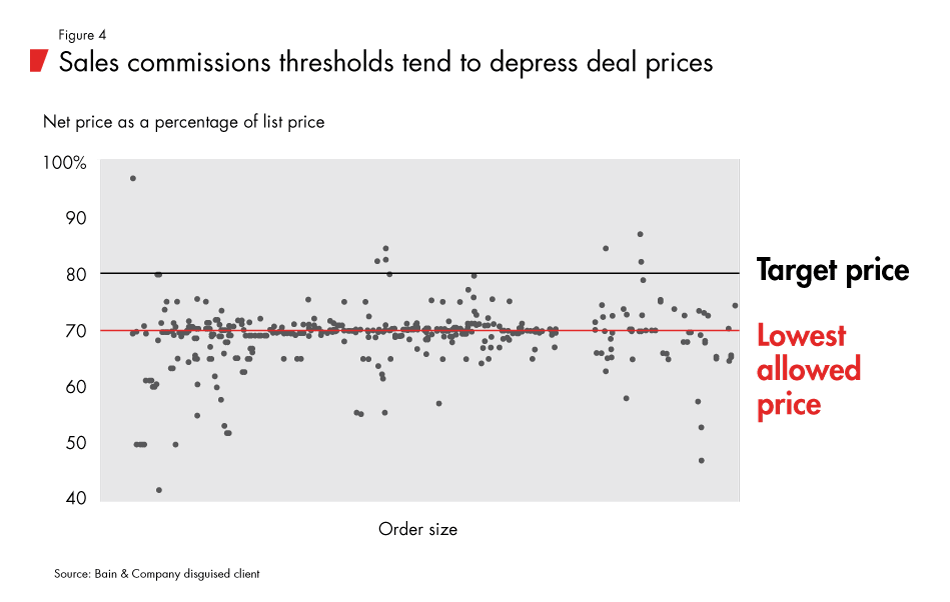
The antidote is to align compensation with the company’s strategic goals and to allow field sales reps to see the effect of price changes on their own compensation. In many cases, this requires maximizing price without sacrificing volume. Incentive plans benefit from the following few principles.
- Clarify the objectives—be they revenue growth, share gains, margin gains or others—and the behaviors that will help meet the objectives.
- Make it foolproof—help sales reps understand the payout calculation, simplify the quota structures and supplemental incentives, and make the upside for outperformance meaningful.
- Ensure transparency—sales reps should easily see the effect of a deal’s price on their personal compensation.
- Track the results through regular reviews that flag areas where frontline staff might game the system.
Returning to the case of the industrial goods manufacturer described in the introduction, the company overhauled its incentive program to balance revenue and profit. It created a pricing tool to make the commission on each deal visible to sales reps—for instance, “if I raise the price by $2,000, I earn an extra $700.” Sure enough, reps began to close higher-margin sales. These changes led to a 7% increase in prices, which added 95 basis points as part of a 350-point improvement in margin overall.
Bain Partner Ron Kermisch details the four steps that are important for optimizing margins and incentives, and improving front-line behavior.
Training, tools and forums—often afterthoughts—can have a big payoff
Top performers invest in building the capabilities of the pricing team through training and forums for best-practice sharing. This runs counter to the norm at many sales organizations, which give little or no formal training on price realization.
Further, most companies can raise their game by adopting foundational pricing software tools. For example, based on the performance of historical deals, software solutions can provide frontline reps with real-time pricing feedback on the characteristics of a deal underway. Using dedicated pricing software, whether in-house or from a provider such as Vendavo or Price f(x), is associated with 2.5 times stronger pricing outcomes, our analysis finds. Yet despite its proven value, pricing software still has only 26% penetration across surveyed companies (see Figure 5).
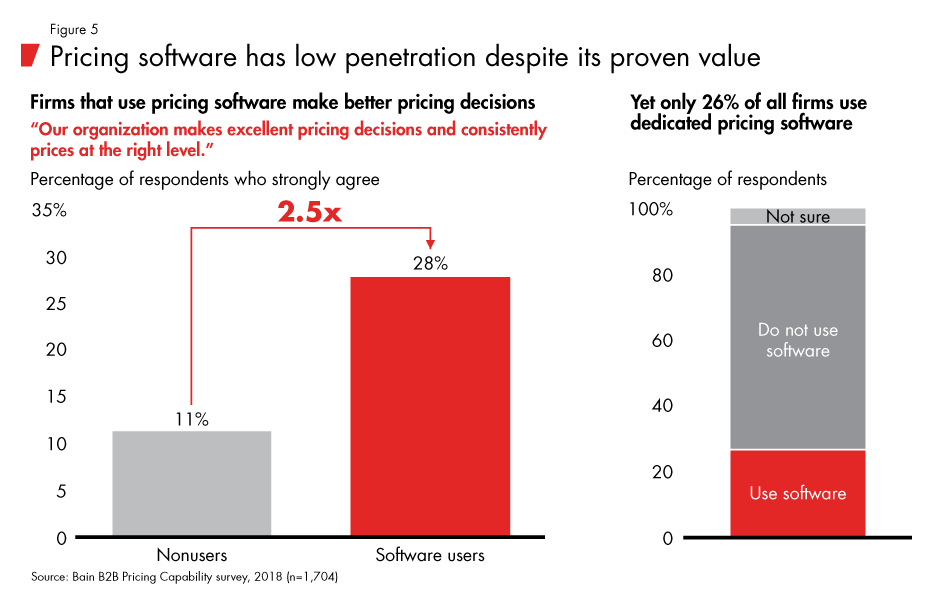
The value of developing capabilities became evident to a specialty chemical producer with lackluster margins. The company had hundreds of different products, each with different competitors, substitutes and customer bases. Product and sales staff could not explain their pricing decisions and often resorted to a rule of thumb summed up by one product manager as “I estimate I can raise the price by 4 cents per pound.” Not surprisingly, she had raised prices by 4 cents per pound for four straight years, leaving money on the table.
By analyzing the various products and their markets, the specialty chemical producer found pricing opportunities that enabled it to increase earnings before interest and taxes by 35% within two years. Just as important, the company set out to raise its game on pricing capabilities. It created forums for sharing best practices, trained product managers in doing fundamental pricing analysis and trained salespeople on how to have better pricing discussions with their customers. New dashboards monitored progress toward pricing goals and flagged places where sales reps might be getting too aggressive. Finally, the CEO reinforced these measures by demanding that the product and sales teams report on pricing actions taken, as well as results, so that effective pricing remained a high priority. The company established itself as a pricing leader in its chemical markets and continued to optimize margins, both by raising prices and by using price to repel lower-cost competitors without giving away too much.
Regardless of a company’s starting point in pricing, there is significant value in building out the capabilities highlighted by our survey analysis. The three areas discussed here have proved to be the most important for upgrading tools, resources and behaviors. That said, companies in almost all industries have underinvested generally across pricing. The episodic “pricing project” approach leaves companies well short of full potential. With meaningful margin upside at stake, managers cannot afford to continue pricing by guesswork or rules of thumb.
Ron Kermisch and David Burns are partners with Bain & Company’s Customer Strategy & Marketing practice. Kermisch is a leader of Bain’s pricing work, and Burns is an expert in building pricing capabilities. They are based, respectively, in Boston and Chicago.




